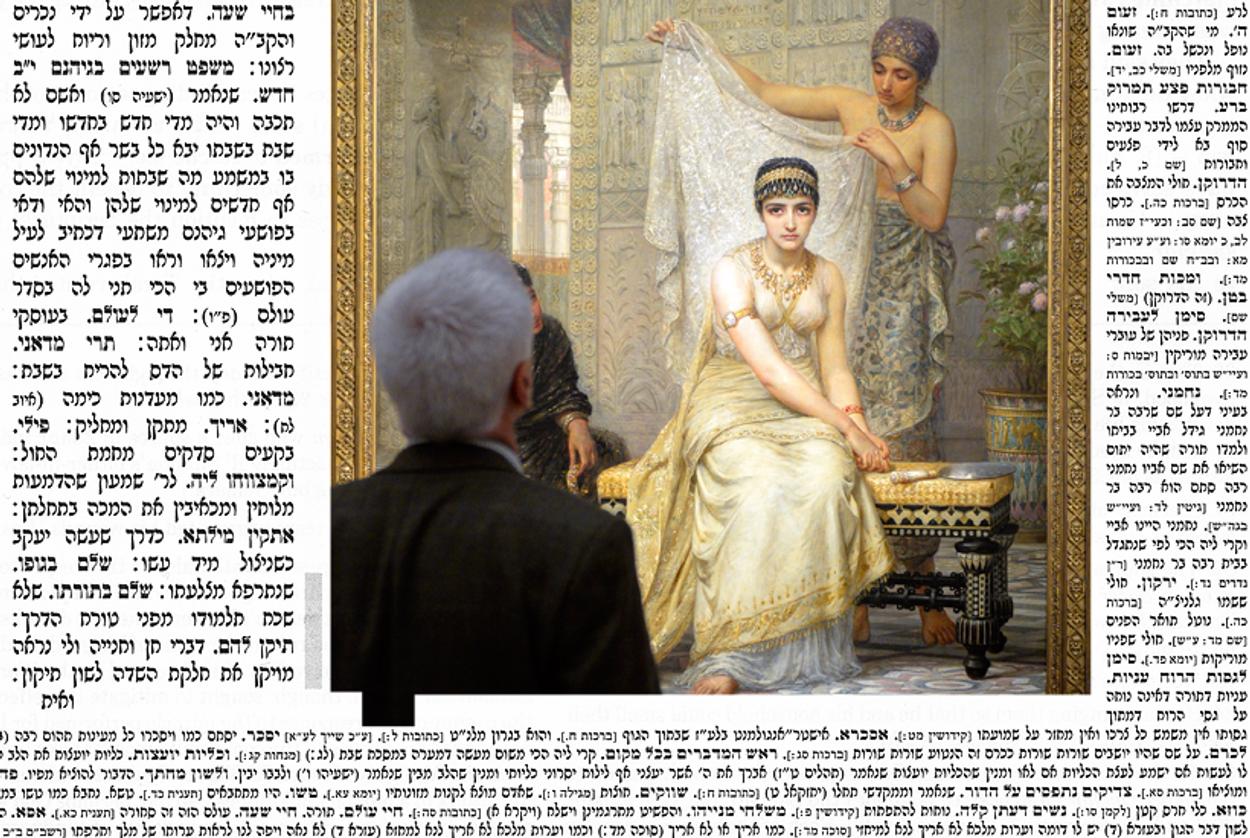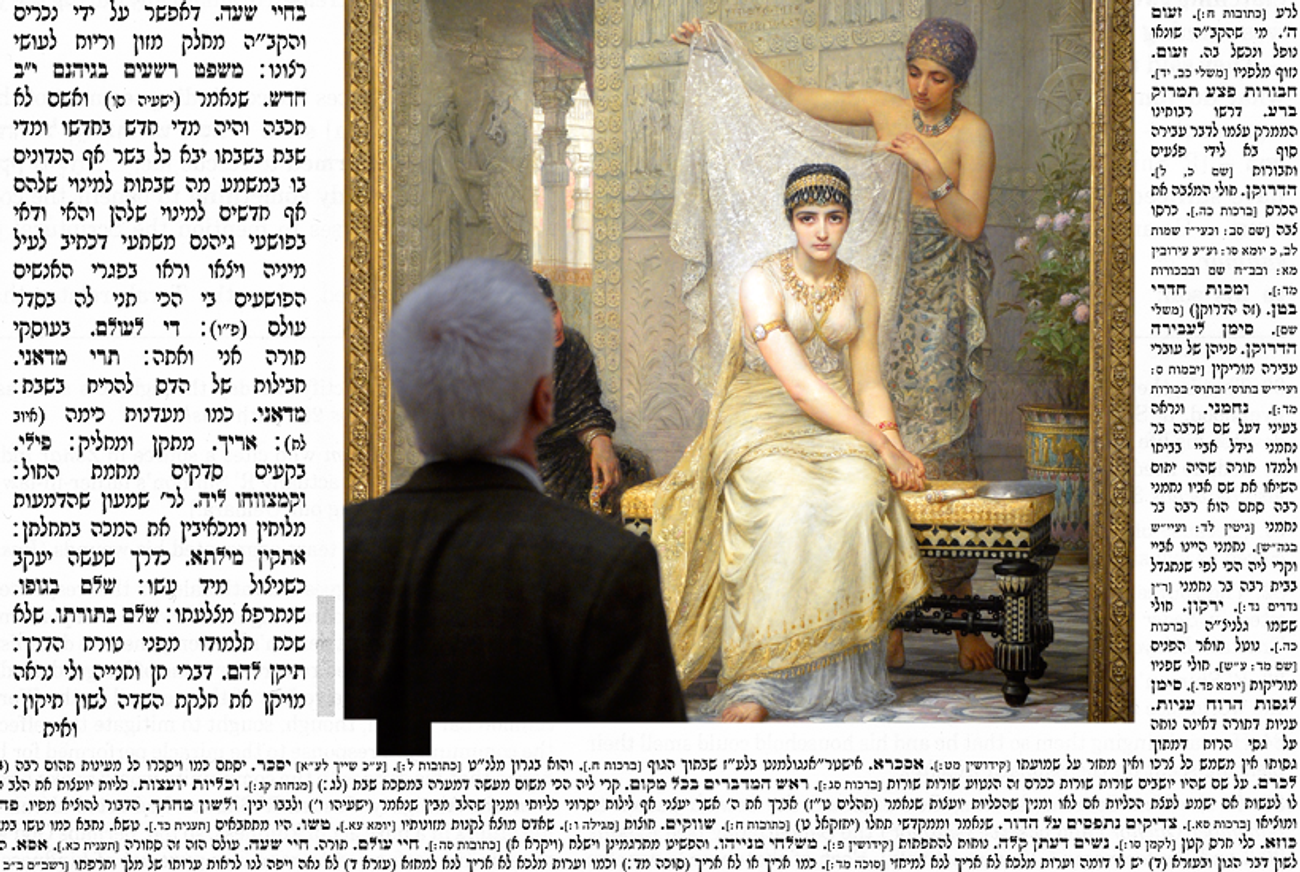When the Talmud Offers Close Readings of Sacred Fictions
Antic embellishments, like Esther being good in bed, help Talmudic rabbis to more fully explicate the text’s divine meaning




Literary critic Adam Kirsch is reading a page of Talmud a day, along with Jews around the world.
One of the great surprises of the Talmud, for me, has been discovering the way the rabbis read the Bible. It would be natural to assume that a contemporary secular reader, unbound by pious traditions or the belief in divine inspiration, reads the Bible with a greater freedom than someone who believes it to be holy writ. And in a sense that is true: Today we are free to interpret the text in human terms, to see miracles as metaphors, or to recognize the tales of King David as propaganda for the Judahite monarchy.
But the rabbis, it turns out, had a different and much greater kind of freedom. To them, every letter and word of the Bible was put there by God, which meant that every letter and word had a meaning. If the same word appeared in a verse in Exodus and again in a verse in Chronicles, then there must be some essential relationship between the two verses that the reader was meant to discover. And the rabbinic reader of the Bible was not even bound by the plain sense of the words: He was free to invent episodes, multiply motives, and add characters, if the result seemed to him a fuller explication of the text’s divine meaning.
This week’s Daf Yomi reading, which brought us to the end of Chapter 1 of Tractate Megilla, offered a master class in this kind of midrashic reading. Over seven pages of Gemara, the rabbis engaged in a chapter-by-chapter, sometimes line-by-line analysis of the Book of Esther, after which the tractate is named. The result is practically a rewriting of the Esther story, full of new details that seem to spring from nowhere but the minds of the rabbis themselves yet are treated as deep truths that the text must have contained from the beginning. At times euphemistic and puritanical, at times surprisingly frank, the rabbis show how they take the ambiguous story of Esther and assimilate it to their own worldview.
The analysis begins on Megilla 10b with the very first word of the Book of Esther: vayehi, “And it came to pass.” “This matter is a tradition from the members of the Great Assembly: Anywhere that the word vayehi is stated, it is a term of nothing other than grief,” the Gemara explains. It goes on to list a dozen or so instances of the word from all over the Bible—demonstrating the rabbis’ amazing knowledge of the text, in an age before concordances (or search engines). Vayehi turns up in the Tower of Babel story, in the story of Hannah and Samuel, and in the story of Saul and David, each time in close proximity to some bad news: The Tower is destroyed, Hannah is unable to conceive, Saul turns against David.
Yet the rabbis know the Bible so well that they are also able to come up with plenty of counter-examples. Isn’t it true that vayehi is also used in connection with joyful events like the dedication of the Tabernacle, and Jacob’s first meeting with Rachel? This seems to negate the tradition “from the members of the Great Assembly,” but Rav Ashi rescues it in a characteristically Talmudic fashion, by revising it. Vayehi on its own can introduce good or bad events, but Vayehi bimei—“And it came to pass in the days of”—is always an ominous introduction, as it is in the book of Esther.
Clearly, for the rabbis, much depends upon individual words, and they go on to give more examples. At the banquet that opens the story of Esther, Ahasuerus is said to display “the riches of his glorious kingdom and the honor of his majestic greatness.” The Hebrew here uses two words, kevod and tiferet, which—as Rabbi Yosei bar Chanina notices—are also used in the Book of Exodus to describe the garments of the priests. This is more than a coincidence, or even an allusion: It is, to Yosei, proof that Ahasuerus actually wore the garments of the Jewish high priest, which had been pillaged from Jerusalem at the time of the Babylonian conquest.
Soon the rabbis move on from semantic questions to a more important one. Esther tells the story of a barely averted genocide: Why, the Gemara asks, were the Jews of that generation deserving of such punishment? What was their sin? One opinion is that the Jews were guilty of participating in Ahasuerus’ feast, which meant that they ate non-kosher food. But if so, surely only the Jews of Shushan, the capital, deserved punishment, since the Jews of other provinces couldn’t have attended the feast. Perhaps, then, the Jews’ sin was that they bowed down before a Babylonian idol. But if they committed such a grave sin, why did God forgive them? Simeon bar Yochai has an answer: The Jews weren’t sincere in their worship of the idol but only did it to obey the king; just so, God didn’t sincerely intend to punish them but only acted angry. This is a good example of how the Talmud, in seeking to solve exegetical problems that it created itself, can come up with answers that seem to traduce the larger point of the story. If we are to believe that the whole ordeal of the Book of Esther was a kind of play-acting—a divine pretense of punishment for a pretended sin—then the story loses much of its significance and drama.
When Esther herself enters the scene, the rabbis have a lot of interpretive work to do. If the Jews were being punished for eating non-kosher food, we might ask, what about Esther herself? Surely in all the time she was living in Ahasuerus’ palace, concealing her Jewishness, she must have been eating the same Persian food as everyone else. But to the rabbis, such a transgression by a heroic Jew is inconceivable, so they find a way around it. When the text says, “And [the king] advanced her and her maids to the best place in the house of the women,” Rav assures us that this means “that he fed her food of the Jews.” And if you wonder how Esther could observe Shabbat in the royal palace, Rava has the answer: Esther had seven maids, and she “would count the days of the week by them,” so she always knew when Shabbat was.
These ritual transgressions are cleverly elided, but there’s no way around the glaring sexual irregularity at the heart of the Esther story. She was, after all, used as a concubine by a gentile king. Oddly, in fact, the rabbis heighten Esther’s transgression by declaring, quite arbitrarily, that she was not actually Mordecai’s ward, as the text states, but his wife. This is accomplished by adding a letter to the word bat, “daughter”—as in, “Mordecai took her for his own daughter”—and thus changing it to the word bayit, “house,” a euphemism for wife. Exactly why the rabbis wanted to do this is unclear to me; perhaps they simply felt that the story would be more satisfying if it involved a romance between Esther and Mordecai.
This leads to the highly irregular conclusion that Esther was sleeping with both Ahasuerus and Mordecai at the same time: “She would arise from the lap of Ahasuerus, immerse herself in a ritual bath, and sit in the lap of Mordecai.” Later, in Megillah 15a, we hear some extenuation of this behavior from Rabbi Abba, who says that Esther slept with Ahasuerus only “under compulsion.” Yet the Gemara also makes clear that Esther was, not to put too fine a point on it, good in bed. The reason why Ahasuerus loved her more than his other concubines, Rav says, is that “if he wanted to taste in her the taste of a virgin, he tasted it, and the taste of a non-virgin, he tasted it.”
It is with the character of Haman that the Talmud takes greatest pleasure inventing new details, all of them disparaging. It’s not enough that Haman hated Mordecai; the reason why he hated him, we read, is that Haman used to be Mordecai’s slave. To rub it in, the Talmud says he wasn’t even a good slave—“and he was called: the slave who was sold for a loaf of bread.” And when the tables are turned and Haman is made to lead Mordecai on horseback through the streets of Shushan, the rabbis gleefully refine the humiliation. Haman also had to cut Mordecai’s hair, they say, reducing him to the lowly status of “a bathhouse attendant and a barber”—fitting, because “Haman was the barber of the village of Kartzum for twenty-two years.” (Why the village of Kartzum? The Talmud doesn’t mention its source for this detail.)
Then, to make matters even worse, Haman’s own daughter—thinking that the man on horseback was her father, and the man leading him Mordecai—went up to the roof of her house and dumped a chamberpot full of feces on Haman’s head. When she realized what she had done, she fell off the roof and died. There is something antic, and true to the spirit of Purim, about the way the rabbis pile on the insults. Clearly, midrash was not just a way of honoring the text but a way for the rabbis to express their own emotion and imagination. Modern Jewish literature, perhaps, has its roots in this kind of sacred fiction.
***
To read Tablet’s complete archive of Daf Yomi Talmud study, click here.
Adam Kirsch is a poet and literary critic, whose books include The People and the Books: 18 Classics of Jewish Literature.
Adam Kirsch is a poet and literary critic, whose books include The People and the Books: 18 Classics of Jewish Literature.